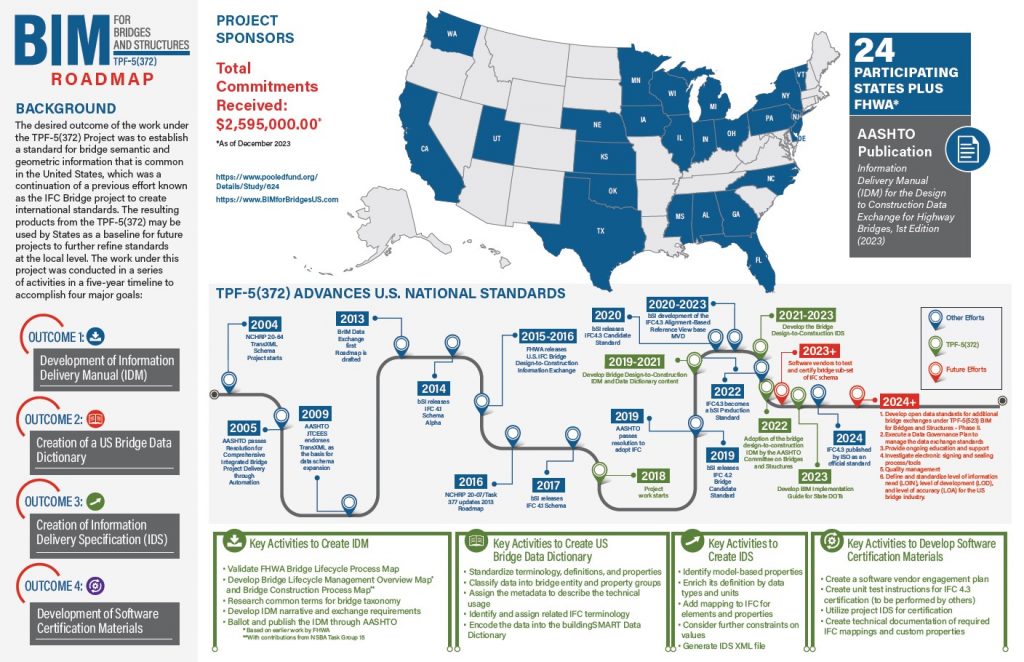By Aaron Costin, Ph.D., Associate Professor, M.E. Rinker, Sr. School of Construction Management, University of Florida and Ines Aviles-Spadoni, M.S., UFTI

The launch of Phase II in an innovative multimillion-dollar initiative marks a significant milestone in the revolutionized way bridges are designed, built, and maintained in the United States. At the forefront of this transformative phase is Dr. Aaron Costin, an associate professor from the University of Florida’s College of Design, Construction and Planning, who plays a crucial role on the project’s leadership team. Spearheaded by more than 20 state departments of transportation and the Federal Highway Administration and in collaboration with the American Association of State Highway and Transportation Officials (AASHTO) Committee on Bridges and Structures, this project is centered around the adoption and implementation of Building Information Modeling (BIM), aiming to streamline and enhance model-based data exchanges across all stages of a bridge’s lifecycle. This forward-thinking approach promises a future where the lifecycle management of bridges—from initial concept through to construction and ongoing maintenance—is significantly improved through the adoption of digital technologies.
The Dawn of Digital Infrastructure
At its core, BIM is a revolutionary process that utilizes 3D modeling software to create a comprehensive digital representation of a structure across its entire lifecycle, from initial design through to construction and ongoing operations. This digital approach facilitates a multitude of applications, enabling more efficient planning, construction, and management of buildings. Yet, until recently, the vast potential of BIM has been largely confined to vertical construction projects like skyscrapers and residential buildings, with the unique needs of transportation infrastructure, such as bridges, yet to be fully addressed.

“Our goals and objectives are poised to transform the future of bridge lifecycle management in the United States by developing the standards and guidelines needed to leverage digital innovations,” Dr. Costin said.
Bridging the Digital Divide
The initial phase of this digital transformation was marked by the TPF-5(372) Building Information Modeling (BIM) for Bridges and Structures project, a collaborative effort funded by a $2.6 million Department of Transportation pooled fund study. This project laid the foundational elements for implementing openBIM® data standards, specifically tailored to the needs of bridges and structures. By developing a common data exchange framework, the project aimed to standardize the way information is shared and utilized across different stages of bridge construction, fostering greater efficiency and collaboration between designers, contractors, and other stakeholders.
Advancing the Future
Building on the successes of TPF-5(372), the next step in this digital evolution is the TPF-5(523) BIM for Bridges and Structures Phase-II Pooled Fund. With an eye on refining and expanding the outcomes of its predecessor, this initiative seeks to develop additional guide specifications for openBIM national data standards. The goal is to enhance model-based exchanges of information, making the process of building and maintaining bridges even smoother and more efficient.
Beyond Bridges: Roads and Infrastructure
In addition to the two bridge Pooled Fund projects, Dr. Costin also has a leading role on yet another multi-million dollar study, in this case for roads and other transportation infrastructure. TPF-5(480) Building Information Modeling (BIM) for Infrastructure represents a collaborative pooled fund designed to unite stakeholders in the advancement of BIM applications for infrastructure projects. This initiative aims to build upon the groundwork established in the BIM National Strategic Work Plan, with a specific focus on enhancing coordination and raising awareness about BIM technologies and their applications. By aligning with the efforts of TPF-5(372) and TPF-5(523), which concentrate on bridges, this pooled fund seeks to ensure a cohesive approach to adopting BIM across different facets of infrastructure development.
The Impact on U.S. Infrastructure: AI and beyond
The implications of these projects extend far beyond the construction of more efficient bridges. By embracing BIM, the U.S. is setting the stage for a future where infrastructure is not only built faster and at a lower cost but is also safer and more sustainable. The integration of BIM with emerging technologies such as digital twins and artificial intelligence (AI) promises to further enhance the capabilities of engineers and builders. Digital twins, or virtual replicas of physical structures, combined with AI, can offer unprecedented insights into the performance, maintenance needs, and potential improvements for bridges and other infrastructure, ensuring they are better equipped to meet the challenges of the future. Dr. Costin is also working on these technologies through his affiliation with the AI2 Center at UF.
“We are already witnessing emerging technologies such as digital twin for bridge structural health monitoring and connected and autonomous vehicles coming from the University of Florida Transportation Institute (UFTI), and it’s only a matter of time before we’ll be seeing AI embedded into all of these applications,” Dr. Costin said. “Such AI integration promises to deliver an unprecedented level of understanding regarding how our bridges and infrastructure perform over time, pinpointing exactly where improvements are needed to withstand the challenges ahead. But before this can all be realized, we need to first achieve the basics of information delivery across the various platforms, which the Pooled Funds set to do.”
As this journey from pooled fund projects unfold, the promise of a digitally optimized future for U.S. bridges and infrastructure is becoming a reality, marking a significant milestone in the quest for innovation, efficiency, and excellence in construction and planning. With experts like Dr. Costin at the helm, the U.S. is paving the way toward a brighter, more sustainable future for its infrastructure and its citizens.